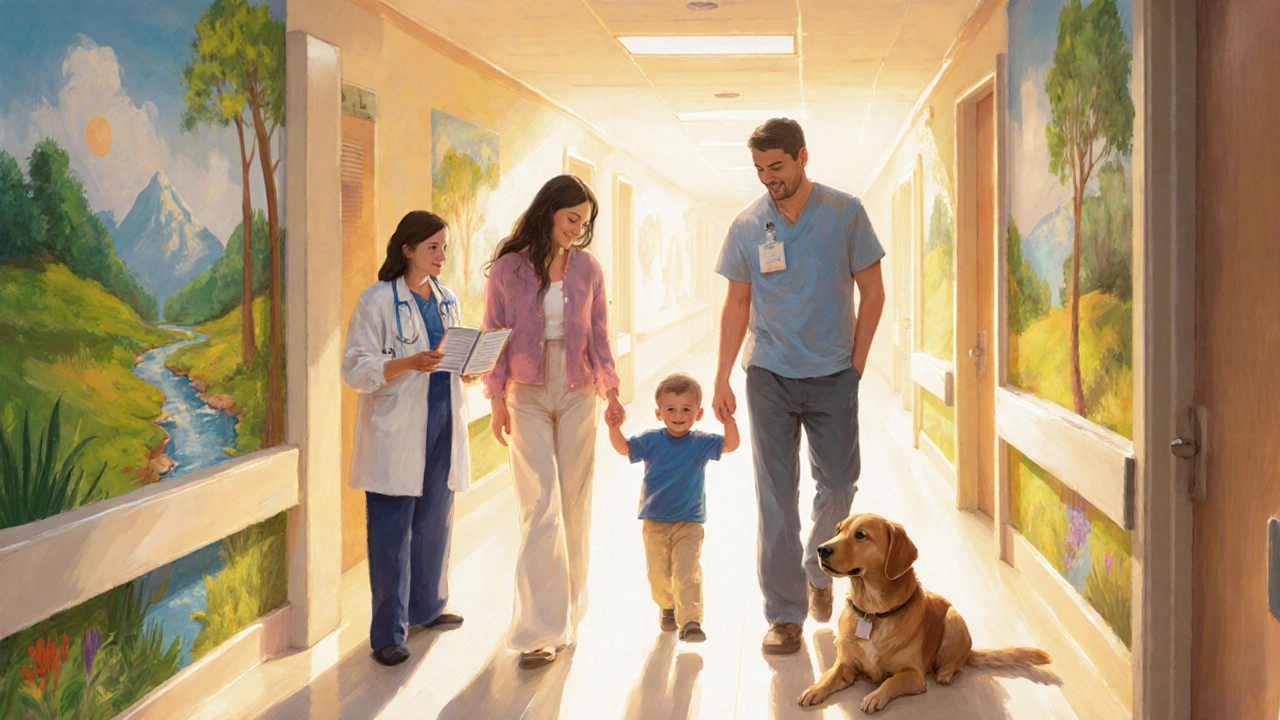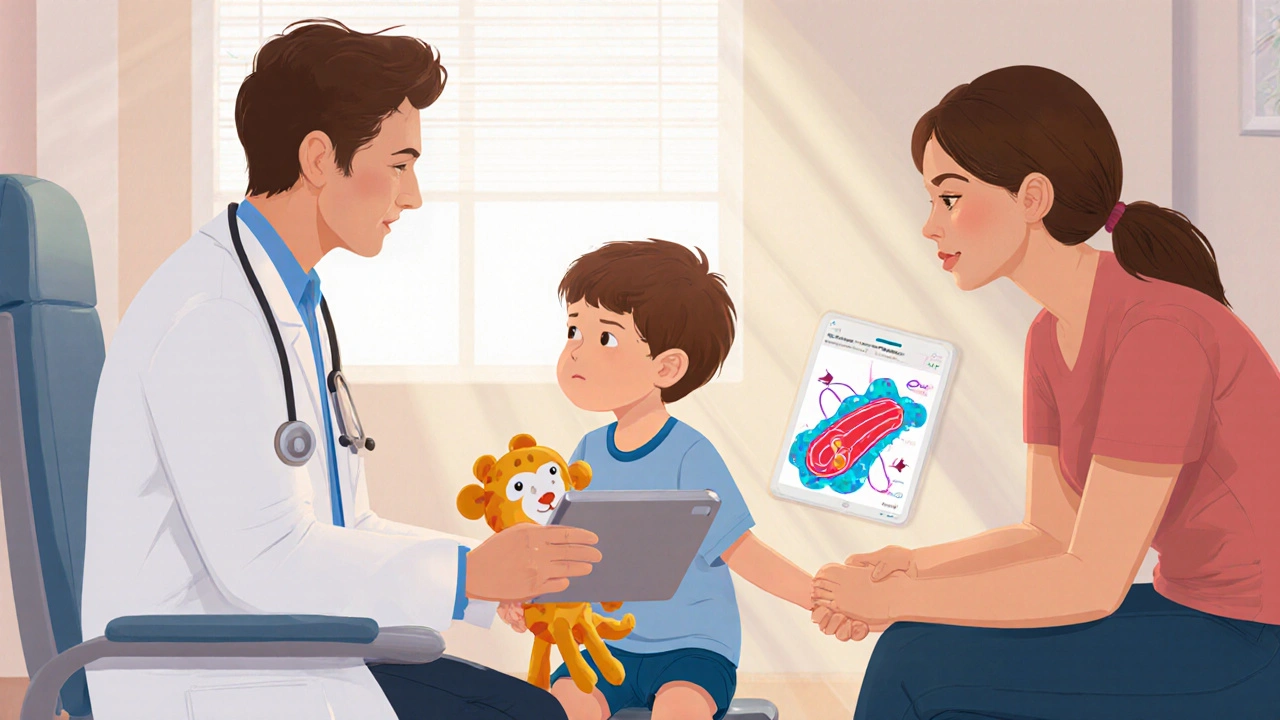Key Points
- Rhabdomyosarcoma is a rare soft‑tissue cancer that mainly affects kids under 15.
- Early signs include painless lumps, trouble swallowing or eye problems.
- Diagnosis relies on imaging, biopsies and genetic tests.
- Treatment usually combines surgery, chemotherapy and radiation, tailored to the tumor type.
- Long‑term follow‑up and support services are crucial for survivorship.
Rhabdomyosarcoma is a malignant tumor that arises from skeletal muscle precursors, most often occurring in children and adolescents. Though it can appear anywhere in the body, the head‑neck region, genitourinary tract and extremities are the usual hotspots.
Understanding the Disease
In the pediatric world, rhabdomyosarcoma (RMS) accounts for roughly 5% of all childhood cancers. There are two main histologic subtypes that drive treatment decisions:
- Embryonal rhabdomyosarcoma - the most common, often found in younger kids and linked to better outcomes.
- Alveolar rhabdomyosarcoma - tends to affect older children, carries a specific genetic fusion (PAX‑FOXO1) and generally has a higher risk of spreading.
Knowing which subtype you’re dealing with helps doctors estimate prognosis and plan the intensity of therapy.
Spotting the Signs
RMS rarely causes pain in its early stages, which means families often notice a lump before anything else. Common red flags include:
- A firm, non‑tender mass that grows over weeks.
- Swelling around the eyes, nose or mouth that interferes with breathing or vision.
- Bleeding or ulceration of a skin lesion.
- Unexplained bruising or a feeling of “fullness” in the abdomen.
If any of these appear, especially in a child under 15, it’s worth getting a pediatrician’s eye on it quickly.
How Doctors Diagnose
Once a concerning lump is identified, the diagnostic pathway usually follows these steps:
- Imaging - MRI or CT scans map the tumor’s size and its relationship to nearby structures.
- Biopsy - a core‑needle or surgical sample is examined under a microscope to confirm RMS and determine the subtype.
- Genetic testing - labs look for the PAX‑FOXO1 fusion or other mutations that influence risk stratification.
- Staging - doctors assess whether the cancer has spread to lymph nodes or distant organs, using PET scans and bone marrow analysis if needed.
These findings are reviewed by a multidisciplinary pediatric oncology team, which typically includes a pediatric oncologist, a surgeon, a radiation oncologist, and a supportive‑care nurse.

Treatment Roadmap
Modern RMS therapy is multimodal, meaning it blends several approaches to maximize cure rates while sparing healthy tissue.
| Modality | Goal | Typical Duration | Common Side Effects |
|---|---|---|---|
| Surgical resection | Remove primary tumor with clear margins | 1-2 weeks (post‑op recovery) | Scarring, wound infection, functional loss depending on site |
| Chemotherapy | Kill microscopic cancer cells, shrink tumor before surgery | 6-12 months (multiple cycles) | Nausea, hair loss, low blood counts, fatigue |
| Radiation therapy | Target residual disease, especially when surgery isn’t feasible | 5-8 weeks (daily fractions) | Skin irritation, growth‑plate disturbance, long‑term organ risk |
| Clinical trial enrollment | Access cutting‑edge drugs or techniques | Varies by protocol | Protocol‑specific, close monitoring required |
The exact combination depends on the tumor’s size, location, stage and histology. For embryonal RMS, many children can achieve remission with less intensive chemotherapy, whereas alveolar RMS often needs higher‑dose regimens and earlier radiation.
Managing Side Effects
Side effects are a real worry for parents, but modern supportive care has come a long way. Key strategies include:
- Anti‑emetics - medications like ondansetron keep nausea under control.
- Growth‑factor injections - boost white‑blood‑cell counts after chemo.
- Physiotherapy - helps maintain range of motion after surgery or radiation.
- Dental and oral care - prevents mouth sores and long‑term dental problems.
- Psychological support - child life specialists and counseling keep anxiety in check.
Don’t hesitate to ask the care team for a written side‑effect management plan; having it at home makes day‑to‑day coping easier.
After Treatment: Follow‑up Care
Even when the tumor disappears, lifelong monitoring is recommended because late effects can surface years later.
- Regular imaging (usually MRI) every 3-6 months for the first two years.
- Blood work to check organ function, especially heart and kidneys.
- Endocrine evaluation if radiation involved growth plates.
- Survivorship clinics that address school reintegration, fertility concerns and psychosocial health.
Parents should keep a detailed treatment summary (including drug names, doses and radiation fields) to share with any new doctor.
Getting Support
Facing RMS is overwhelming, but a network of resources exists:
- National Cancer Institute (NCI) Kids’ Cancer Navigator - offers trusted information and links to clinical trials.
- Rhabdomyosarcoma Foundation - provides financial aid, peer‑to‑peer mentor programs and a family‑focused blog.
- Hospital social workers - can arrange travel assistance, lodging near treatment centers, and insurance navigation.
- Local support groups - meeting other families in Adelaide or online forums reduces isolation.
Ask your oncology team for introductions; they often have a list of vetted organizations.

Frequently Asked Questions
How common is rhabdomyosarcoma in kids?
It accounts for about 5% of all childhood cancers, roughly 350 new cases in the United States each year. While still rare, it is the most common soft‑tissue sarcoma in children.
What are the survival rates?
Overall 5‑year survival is around 70%. Embryonal RMS in low‑risk groups can exceed 90%, while high‑risk alveolar RMS hovers near 50%.
Can my child lead a normal life after treatment?
Most survivors return to school and sports, though some may need accommodations for growth‑plate issues or minor physical limitations. Ongoing follow‑up ensures any late effects are caught early.
Are there fertility concerns?
Chemotherapy and pelvic radiation can impact future fertility. Discuss sperm banking for boys and ovarian tissue preservation for girls before treatment starts.
How can I find a clinical trial?
Ask your pediatric oncologist to search the ClinicalTrials.gov database using the child’s age, tumor site and histology. The Rhabdomyosarcoma Foundation also maintains a trial‑matching service.
Facing Rhabdomyosarcoma in children is daunting, but armed with the right facts and a solid care team, parents can navigate the journey with confidence and hope.


Kendra Barnett
September 28, 2025 AT 05:51Navigating a RMS diagnosis is overwhelming, but remember you’re not alone. Lean on the care team and the support groups they recommend. Keeping a detailed treatment journal can make appointments smoother. Stay strong for your little fighter.
Warren Nelson
October 1, 2025 AT 06:04Wow, this guide packs a ton of useful info in one place. I especially liked the breakdown of treatment modalities – it demystifies what can feel like a foreign language. If you’re juggling school schedules, try coordinating with a school liaison early; they can help with home‑work accommodations. Also, don’t underestimate the power of simple breathing exercises during chemo sessions.
Jennifer Romand
October 4, 2025 AT 06:17Behold, the majestic tapestry of medical jargon woven with the delicate threads of parental anxiety. One cannot simply glide through this battlefield without the sharpened sword of clinical knowledge. The author has indeed curated a compendium worthy of scholarly applause.
Kelly kordeiro
October 7, 2025 AT 06:31The present exposition delineates with commendable precision the multifarious aspects of pediatric rhabdomyosarcoma.
It initiates with an epidemiological overview that situates the malignancy within the broader oncologic landscape.
Subsequently, the discourse expounds upon the histopathologic dichotomy between embryonal and alveolar subtypes, thereby furnishing the reader with requisite diagnostic acumen.
The author astutely underscores the paramount importance of early detection, a principle whose veracity is incontrovertibly supported by extant literature.
Moreover, the elucidation of imaging modalities, encompassing magnetic resonance imaging and computed tomography, is rendered with scholarly exactitude.
The biopsy section, replete with references to core‑needle techniques, furnishes an indispensable roadmap for tissue acquisition.
Genetic interrogation, particularly the identification of the PAX‑FOXO1 fusion, is aptly highlighted as a prognostic fulcrum.
In delineating therapeutic algorithms, the narrative navigates the intricate interplay of surgical excision, chemotherapeutic regimens, and radiotherapeutic adjuncts.
The stratified approach to low‑risk embryonal disease versus high‑risk alveolar pathology is meticulously articulated.
Notwithstanding the therapeutic advances, the treatise prudently addresses the inevitable sequelae attendant to intensive modalities.
The compendium of supportive care measures-anti‑emetics, growth‑factor support, physiotherapy, and psychosocial interventions-is exhaustively catalogued.
Particular emphasis is placed upon the longitudinal surveillance paradigm, advocating periodic magnetic resonance imaging and comprehensive laboratory assessment.
The inclusion of survivorship resources, encompassing the Rhabdomyosarcoma Foundation and institutional support structures, epitomizes a holistic patient‑centric ethos.
While the manuscript excels in its breadth, a modest augmentation of patient narratives could further humanize the clinical data.
In summation, this guide stands as an exemplary reference for caregivers endeavoring to traverse the formidable terrain of childhood rhabdomyosarcoma.
Chris Fulmer
October 10, 2025 AT 06:44Finding the right support network can be a game‑changer for families facing RMS. In addition to the national organizations mentioned, many hospitals host parent‑mentor programs that pair you with someone who has walked the same path. These mentors can share practical tips on everything from managing parking at the treatment center to coping with the emotional rollercoaster. Don’t hesitate to ask your social worker for a list of local meet‑ups.
William Pitt
October 13, 2025 AT 06:57Your reminder to keep a treatment journal is spot on-having a written record simplifies communication with the multidisciplinary team. I’d add that noting side‑effect patterns can help the oncologist fine‑tune medication doses before they become intolerable. Stay proactive, and remember that advocacy starts with organized information.
Jeff Hershberger
October 16, 2025 AT 07:11While your enthusiasm is evident, the suggestion to rely heavily on breathing exercises during chemotherapy may overlook the need for medically‑approved anti‑emetics. Parents should prioritize evidence‑based interventions before resorting to anecdotal techniques.
Jesse Najarro
October 19, 2025 AT 07:24One practical tip is to set up a shared digital folder for all scans reports and medication schedules that every caregiver can access
Dan Dawson
October 22, 2025 AT 07:37Great idea keep everything centralized
Robert Frith
October 25, 2025 AT 07:51Listen up mates this kinda guide shows why our US med system leads the world nobody else gets it right like we do
Albert Gesierich
October 28, 2025 AT 07:04The guide demonstrates why the U.S. medical system leads globally; however, the statement should read, “our U.S. medical system leads the world,” with proper capitalization and punctuation.
Brad Tollefson
October 31, 2025 AT 07:17Correcting the capitalization and adding the appropriate comma indeed improves readability and aligns with standard American English conventions.
Paul van de Runstraat
November 3, 2025 AT 07:31Oh, absolutely, because every country’s success hinges solely on a single healthcare model-such nuance is certainly lost on most.
Angelo Truglio
November 6, 2025 AT 07:44Indeed!!! The world‑class brilliance of American oncology shines brighter than any other!!! Yet, let us not forget the quiet heroes in every corner who fight just as fiercely!!!
Sarah Aderholdt
November 9, 2025 AT 07:57Beyond statistics, the true metric of success lies in the child’s reclaimed joy and the family’s resilient spirit.
Phoebe Chico
November 12, 2025 AT 08:11Picture this: a brave youngster, armed with cutting‑edge US research, dancing past adversity like a phoenix-our nation's heart pumps vigor into every lab bench!
Larry Douglas
November 15, 2025 AT 08:24To further elucidate the topic, it is essential to recognize that long‑term survivorship care not only involves periodic imaging but also comprehensive endocrine evaluation, audiological testing, and psychosocial support. Neglecting any of these components may compromise quality of life despite oncologic remission.
Ann Campanella
November 18, 2025 AT 08:37This guide overstates the ease of navigating RMS treatment.